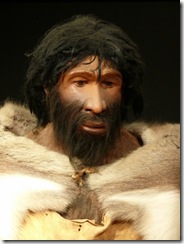 GenomeWeb Daily News published a story on Friday entitled “En route to Neandertal Genome, Researchers Analyze Its Complete Mitochondrial Genome” which revealed the results of recent Neanderthal mtDNA analysis.
GenomeWeb Daily News published a story on Friday entitled “En route to Neandertal Genome, Researchers Analyze Its Complete Mitochondrial Genome” which revealed the results of recent Neanderthal mtDNA analysis.
On Thursday May 9th, Svante Pääbo spoke at the Biology of Genomes meeting at Cold Spring Harbor Laboratory. Pääbo’s group, along with 454 Life Sciences, is currently engaged in a project to sequence the Neanderthal genome. The researchers have been able to sequence the complete Neanderthal mtDNA genome with 35-fold coverage. The genome is approximately 16 kilobases long and differs from the CRS at 133 positions. From what I’ve been able to find online, it doesn’t appear that the actual sequencing results have been released to the public. Given current estimates of mtDNA mutation rates, the number of differences between human and Neanderthal mtDNA suggests that the branches diverged approximately 600,000 years ago.
Although there have been accusations that Neanderthal sequencing is often contaminated by human DNA, the concerns have been addressed by Pääbo’s group. From the article:
Pääbo mentioned that about 10 percent of the DNA library they initially sequenced – data they published in late 2006 – consisted of modern human DNA. But over the last two years, they have been guarding against contamination by generating DNA libraries in a clean room and by barcoding the Neandertal DNA.
The ISOGG has a page devoted to Neanderthal DNA for more information.
I believe that this project will show conclusively that Neanderthals were a separate species and that, like donkeys and horses or lions and tigers, they would be able to interbreed, but produce sterile offspring. This answers the dicotomy of interbreeding evidence at Carmel but no evidence of lingering DNA in the modern population. In any case, this will be wonderful work to read more about.